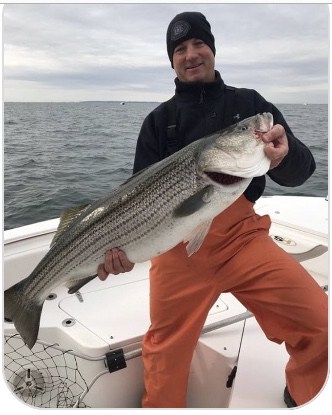It’s no surprise that anglers across the world are in search of the biggest, toughest fish they can, one that will truly give them the fight of their life. There’s nothing quite like the euphoric feeling of pulling the biggest catch of the day out of the water and either showing it to your fishing buddies or just enjoying the self-pride of landing a monster. One of the most sought after fish in the fishing community is the striped bass. Commonly known as the Striper.
While states like either of the Carolinas, Arkansas, and Kentucky are well-known for Striper fishing, you can actually find them swimming in bodies of water all over the United States.
On the West Coast, they are known as transplant fish. In 1878, 137 Striper fry were released in San Francisco Bay, which spurred the beginning of Striped Bass transplants across the West.
The Oregon Fish and Wildlife website state that “the fish’s migratory urges brought them to Oregon’s Coos River system by the late 1800s.”
Since then, Fishermen and women have made it a goal to chase and catch the fish of their dreams. For some, that dream lies in Oregon, but where is the best place to fish for Stripers in Oregon?
- The Coos River/ Coos Bay
- The Coquille River
- The Columbia River
- The Smith River
- The Umpqua River

Incase you need striped bass lures I linked some awesome choices here.
- The Coos River/ Coos Bay
In no particular order, the Coos River /Coos Bay takes the number five spot. While the Coos River is surprisingly only five miles long, it is formed by the confluence of its major tributaries.” The South Fork Coos River, and the Millicom River. A confluence is where two rivers meet and is clearly separated into two separate tributaries. The river flows into Coos Bay, which is Oregon’s largest bay. It is on the Pacific coast of Southwest Oregon. Interested in making a living by writing about the outdoors? The Stripers and other species like to hang out on the confluence line to spot out smaller game fish for feeding. When the two waters meet, in some cases you can see the line that forms the confluence. This makes for an ideal location to bait your hook and drop a line. Fishing in the Coos River is particularly an interesting experience due to this phenomenon. Stripers like to hang out in rivers because the higher volume of the conjoining rivers puts more oxygen in the water. In today’s day and age, the Coos River and Coos Bay are abundant with Chinook Salmon, Rockfish, crabs, and clams, and 2
perch, but you can occasionally still catch Striper, and that’s why it takes the number 5 spot. - The Coquille River
At number four we have the Coquille River. The Coquille River stretches 36 miles and is located in Southwest Oregon. The 1,059-square-mile mountainous area of the southern Oregon coastal range drains into the Pacific Ocean. The river flows through the towns of Myrtle Pointe and the town of Coquille and runs into the ocean at Bandon. Striped bass like to inhabit areas with lots of structure to swim through and explore for food and the Coquille River has plenty of that. There is no shortage of trees and brush that line the walls of the River, and if you can get your boat into one of these areas with lots of brush and cast in the right spot, there is no doubt you’ll be leaving with plenty of stories to talk about. Just don’t get your line caught, because we all know that feeling. The Coquille River has a Steelhead hatchery, and while Steelhead fishing is great there, most areas enforce strict catch and release policies due to fishermen catching and keeping them before they reach maturity. Unlike the Coquille River’s Stripers that can get larger than 24 inches in length, true keepers became harder to come by before these policies were set into place. Near the town of Coquille, you can occasionally get on a school of Shad to help you catch striper, however, if this method doesn’t seem to work, crank baits are also reliable lures that can help on tougher days out on the water. This river takes the number four spot due to the slowing demand for Striper fishing in the area in recent years, but if you’re a seasoned fisherman or one confident son-of-a-gun, and you play your cards right, the Coquille River still has a lot to offer. - The Columbia River
The Columbia River is the largest river in the Pacific Northwest, beginning in British Columbia, Canada, and flowing down throughout the state of Washington. The waterway turns west through Oregon on its way to empty into the Pacific Ocean. The river, a whopping 1232 miles long, has been crucial to the economy and history of the Northwest region of the United States. Despite having been used for travel between the Northwests many cultural groups, before 2013 stripers were rarely ever found in the 3
river, especially up North throughout regions of Washington and Canada. That all changed in 2013 as stripers started showing up in the lower Columbia River. That year, a 52-pound striper was actually caught in the river by accident. Upon closer inspection, the fish was found to be carrying 10 pounds of roe, eggs that would have hatched had the mother not been accidentally taken from the water. Despite this incident, stripers have been more and more abundant in recent years. This goes to show how far this species can spread throughout an entire ecosystem. It’s a rarity to see the stripers that travel that far north, especially in Washington. They are very few in numbers and far between, however you can still find some in the lower Columbia River in Oregon. - The Smith River
The Smith River runs 90 miles and is a main tributary of the Umpqua River. The Smith River was named after Jedediah Smith, the leader of a group of explorers traveling from Utah to Northern California and Oregon. They discovered the Smith River and camped along the Umpqua River near the Smith River’s mouth. The company was attacked by a group of natives, leaving 15 of the explorers dead and many more wounded. Like the Umpqua River, the Smith River tributary is a great place to fish for Striped Bass in Oregon, but only under certain circumstances. The fishing is hit-or-miss in this area. Stripers aren’t native to these waters, and most come in from the Pacific ocean. This explains why stripers, although rare to find, are typically very large for this waterway. They have plenty of time to grow up and mature, making their way up these rivers, and since not many people are fishing for them, it’s a true wonder when such a large bass takes the bait. It sure is a niche area to catch Stripers, but as I said, these things get huge. - Umpqua River
Arguably the top place to fish for Striped Bass in Oregon, the Umpqua River is located along the Pacific coast of Oregon. The Umpqua River, originally inhabited by the Coquille tribe of Native Americans in the early 19th Century, was named after a band of the tribe called the Umpqua. The river stretches 111 miles through Douglas county and has recently become a legendary fishing spot thanks to one lone fisherman: Beryl Bliss. 4
In 1973, Beryl reeled in a 68-pound monster, marking his spot as the Oregon record holder for the heaviest Striped Bass in the state. Not much information is known about this record considering it was set in 1973 before the age of modern technology, but I bet, to this day, Beryl is proud of setting a record and taking his place as the angler that caught the biggest Striper in Oregon. The Umpqua River continues to thrive with Stripers and other species of fish. It is still a sought-after river to fish in Oregon, and won’t disappoint as a great place for family and friends alike to search for the next record-setting Striper. Maybe if you’re lucky enough, and are as good of an angler as you brag you are to your buddies, you may even break Beryl’s record.
When one considers the history behind these truly incredible fish and how one implantation started a frenzy of expansion and growth, it becomes clear that this was no mistake. It’s fascinating to hear the stories and pass on the legends of days gone by, stories of how the Striped Bass got there, and where they are now. The trek from the San Francisco Bay to the rivers of Oregon, from tiny fry to a 68-pound monster, was a long but rewarding one for this species. The history behind these five rivers alone validates their spots on the list. They show that Oregon is truly the home to some of the most complex ecosystems in the world, let alone the United States. Next time you’re fishing the rivers of Oregon, stop and think about where these fish came from, and how far it traveled to get there. When someone catches a striper in Oregon, it’s a story that is passed around for years, especially when they are larger than ever expected. Oregon remains a coveted location that everyone should try to fish at least once. If you get the chance, the Coos River, Coquille River, the Columbia River, the Smith River, and lastly the Umpqua Rivers are your best bet. Good luck, and good fishing.
Hey FISHMONGER – make sure to check out my FISHING RESOURCES page.

